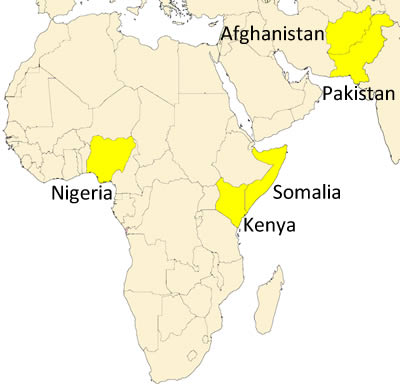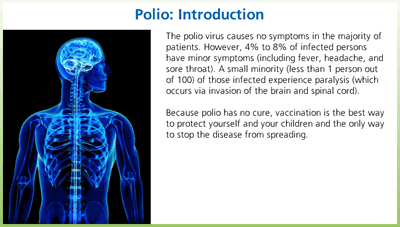
Five countries where polio is making a comeback.
Click here to test your knowledge about
polio by answering these five questions.
Polio can be prevented through immunization with the polio vaccine, which is the only protection against this paralyzing disease. The two types of vaccine that can prevent polio are oral polio vaccine (OPV) and inactivated polio vaccine (IPV).
Both IPV and OPV offer almost 100% immunity. There are three types of polio virus, based on the type of viral protein. Regardless of the type of polio vaccine used, the dosing immunization schedule is nearly the same. It is usually given in a series of four doses: at 2 months, 4 months, 6 to 18 months and again between 4 and 6 years of age.
Oral polio vaccine (OPV) consists of a mixture of live, attenuated (weakened) polio virus strains of all three polio virus types. Because it is administered orally, OPV is relatively inexpensive, effective, and usually induces long-lasting immunity to all three types of polio virus, although it does carry a very slight risk of transmitting the disease.
The inactivated polio vaccine (IPV) consists of inactivated (killed) strains of all three polio virus types. IPV is given by intramuscular injection. Because IPV is not a live vaccine, it carries no risk of vaccine-associated polio paralysis (VAPP). IPV is the most common type of vaccination used in the United States.

From WiRED's Polio training module.
WiRED International Debuts Polio Module As
Polio Makes a Comeback in Five Countries
BY SHAWN GHUMAN; EDITED BY BERNICE BORN
A
s polio resurfaces in five countries, including Kenya, the fight for the worldwide eradication of this highly infectious and potentially deadly disease is suffering a setback. In response, WiRED recently developed a healthcare training module on polio, which our team will bring to Kenya in early September. Although there is no available cure and little treatment for polio, the module will stress prevention—the most important step in combating polio’s spread.
In 2012, the world saw only 223 cases of polio, the lowest level in history, yet this recent outbreak causes concern. In April 2013, a 4-month-old girl suffering from acute paralysis, a major symptom of the disease, was diagnosed with polio in Dadaab, Kenya,—home to 500,000 people in the world’s largest refugee camp—near the Somali border. Not long after, two children nearby were also diagnosed with the disease. Why are these cases of such concern?
According to the World Health Organization (WHO), as long as a single child remains infected, children in all countries are at risk of contracting polio. This is because polio is extremely contagious, and a single case can quickly spread this virulent disease far and wide. Failure to eradicate polio could result in as many as 200,000 new cases every year. In a recent National Public Radio interview, WHO spokesman Sona Bari said, “Polio is a virus that spreads silently. One case represents between 200 and 1,000 people infected. It’s the tip of an iceberg.”
Only the polio vaccine, given multiple times, can protect a child for life. To combat the possible spread from the recent outbreak, the Kenyan government launched a one-week vaccination campaign in May that aimed at reaching 4.3 million children, as well as immunizing all residents of the Dadaab refugee camp. The vaccination program will be launched again in August.
To help people understand this disease and to recognize the critical importance of vaccinations, WiRED is providing a training module on its W-HELP website and in its portable health libraries. This interactive application will teach people about the transmission of polio, its symptoms and its potentially debilitating outcomes.
This latest polio outbreak is not the first of its kind, and as long as we continue to educate people in regions at risk of this terrible disease, the campaign for global eradication of polio will be strengthened.
Learn more by going through the module.


WiRED Health Education
Learning Portal
^ Back to the Top
|

